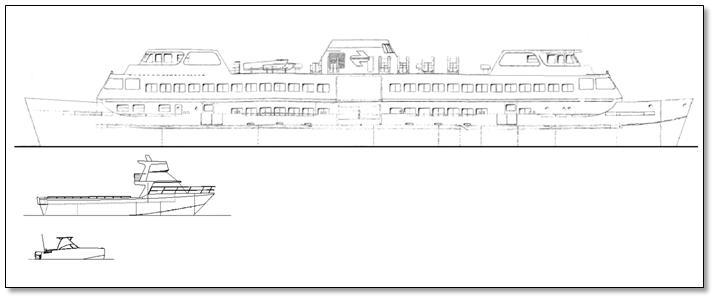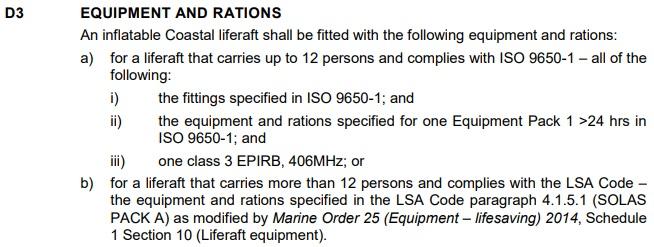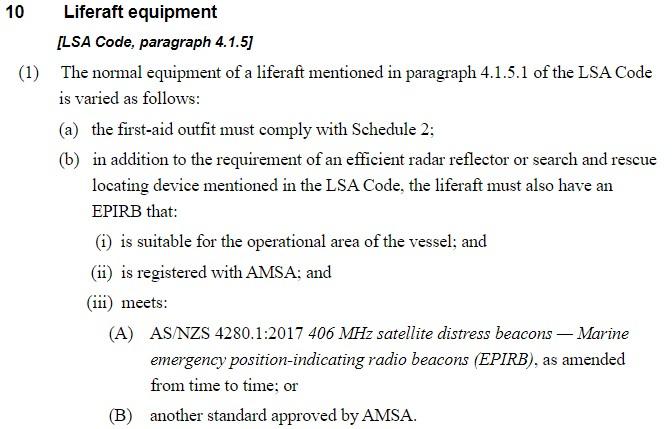In this edition
- Accreditation matters
- MARS matters
- Certificate of survey renewal applications
- AMSA’s new National Compliance Plan 2020-21
- Have you got the right tools for the job?
- Audit findings – EPIRBs and coastal life rafts
- Vessel descriptions in stability documentation
- Disputed deficiencies during initial survey
Accreditation matters
AMSA continues to receive incomplete applications for renewal of surveyor accreditation. Please note that section 28 of the regulations requires an application for re-accreditation to be made at least 3 months before expiry of accreditation.

When submitting an application please ensure that:
- All necessary fields are completed in full.
- Your signature remains strictly within the box provided. This ensures we can crop it correctly for your ID card.
- Your photo is 45mm x 45mm on a white background, facing forward from the neck upwards. If possible, this should be scanned at 300dpi.
- You supply current evidence of professional association membership. If you are submitting a receipt of membership you must advise the renewal and expiry date.
- You supply evidence of continued professional development. Submit copies of certificates from training courses, workshops or additional qualifications. If you don’t have certificates tell us in the box and provide attendance dates. Provide the date of subscription and name of any publications you subscribe to. Provide dates and names of any technical meetings or conferences you have attended. If you mentor, tell us who, what the subject is and any dates.
- You submit a copy of your electrical license if you are accredited in categories e, f or m.
- Payment is made quoting the transaction reference number (TRN) shown in the top right corner of the application form. If you make a mistake on the application and print another one, a new TRN will generate. You must advise us of the TRN for your payment.
Access the renewal application form. Due to COVID-19, all applications including supporting documentation must be emailed to DCVSurvey@amsa.gov.au until further notice.
MARS matters
Recently we’ve been asked about the system validation, when a surveyor attempts to claim a survey code in MARS. The table below shows the category of accreditation MARS looks for when a surveyor claims an activity.
This table is also available on the find an accredited marine surveyor page.
Note that material and length conditions apply to categories a, g and l. Length conditions also apply to category k.
| MARS Activity | MARS criteria (surveyor must have the appropriate category listed) |
| Plan Approval Survey (PLAN) | (a) initial survey – plan approval |
| Loadline Assignment (ILAS) | (c) initial survey – load line – assignment |
| Initial Hull Structure Survey (IHST) | (g) initial survey – construction or alteration – hull, deck and superstructure |
| Initial Engineering Survey (IENG) | (h) initial survey – construction or alteration – machinery |
| Initial Fuel Tank Survey (IFTA) | (h)initial survey – construction or alteration – machinery |
| Initial Shaft Survey (ISHA) | (h) initial survey – construction or alteration – machinery |
| Initial Fire Systems and Fitout Materials Survey (IFIR) | (g) initial survey – construction or alteration – hull, deck and superstructure (h) initial survey – construction or alteration – machinery |
| Draft Mark Survey (IMAR) | (b) initial survey – stability approval (g) initial survey – construction or alteration – hull, deck and superstructure (c) initial survey – load line – assignment (i) initial survey – construction or alteration – load line conditions and markings |
| Watertight and Weathertight Integrity Survey (IWWI) | (g) initial survey – construction or alteration – hull, deck and superstructure |
| Initial Loadline Survey (ILOA) | (i) initial survey – construction or alteration – load line conditions and markings |
| Initial Electrical Survey (IELE) | (d) initial survey – electrical – extra low voltage (e) initial survey – electrical – low voltage (f) initial survey – electrical – high voltage |
| Initial Lightship Check or Inclining Survey (ILIG) | (b) initial survey – stability approval |
| Stability Assessment (STAB) | (b) initial survey – stability approval |
| Commissioning Survey (COMM) | (k) initial survey – construction or alteration – commissioning |
| Exemption 40 In and Out of water Survey (X40S) | (l) periodic survey |
| Periodic (in water) Survey (PRDC) | (l) periodic survey |
| Out of water Survey (OWAT) | (l) periodic survey |
| Shaft Survey (SHAFT) | (l) periodic survey |
| Periodic Loadline Survey (LOAD) | (n) periodic survey – load line |
| Periodic lightship check (LITE) | (b) initial survey – stability approval (l) periodic survey |
Certificate of survey renewal applications
We still see vessel owners forgetting to submit applications to renew certificates of survey. Please remind your clients that certificates of survey are not automatically issued when AMSA receives a survey recommendation from the surveyor. An application is required for a certificate of survey to be renewed. An initial survey application is required if the vessel has undergone a change mentioned in Schedule 1 of Marine Order 503 or been out of survey for more than 2 years.
AMSA’s new National Compliance Plan 2020-21
AMSA’s new National Compliance Plan 2020-2021 is now available.
The plan aims to provide a transparent overview of our compliance focus areas over the coming year and our compliance responses.
Focus area 3 in the plan addresses DCVs. Several technical issues including failure of engines, steering-gears, and anchoring systems are priority areas for AMSA’s compliance activities over the coming year.
Please familiarise yourself with the plan and share this information with your clients as the opportunity arises.
Have you got the right tools for the job?
Did you know that a surveyor is able to create their own survey forms, tailored to the type of vessel?
The range of surveyed vessels is significant. Passenger vessels, workboats, fishing vessels, small to large... you name it, there is probably someone operating it commercially and as surveyors, we are expected to provide services to this expansive range of vessels.

In order to increase consistency and reduce entry barriers for new surveyors, AMSA provides a range of “one size fits all” survey forms surveyors may use. These are freely available from us.
Nonetheless, some experienced surveyors develop their own survey reports tailored to the job. This ensures they create an accurate survey record and reduce administrative hours. Tailoring survey reports to individual vessels, or types of vessels, is an effective way to stand out in the market.
If the only tool you have is a hammer, it’s hard to eat spaghetti — David Allen
Surveying a 6m 2C vessel? Use your small outboard powered survey report.
Surveying a 70m 1B passenger ferry, with RO-RO and dangerous goods? No problem, use the comprehensive survey reports you have developed covering these elements.
Where the authority comes from and the conditions
The Surveyor Accreditation Guidance Manual (SAGM) – Part 2, Section 2.9.1 (6) states that:
A surveyor who submits survey reports and recommendations using MARS is not required to use the forms identified in Annex 1.
This allowance is conditional on the recommendation and documents being directly uploaded in MARS by the surveyor. It is also conditional on the survey report having adequate and clear content for the kind of vessel being surveyed. Section 2.9 of SAGM Part 2 provides further details around these requirements.
As guidance, AMSA recommends survey forms include at least the (relevant) information identified on the AMSA generic forms. Allowing a surveyor to remove irrelevant content. For example, there would be no need to report on engineered seawater cooling systems on a report for a simple outboard powered vessel.
By cutting out irrelevant information, surveyors can reduce administrative time and provide a higher level of service to distinguish themselves in the market.
Please be careful with the trimming. Unclear submissions lacking relevant information may result in delay for your client or refusal of an application.
Audit findings—EPIRBs and coastal life rafts
Since January, we have been conducting desk-top audits as part of the accreditation renewal process.
Generally, the work conducted by surveyors has been of a good standard. However, we have noticed some common non-conformances. For example, coastal life rafts containing an EPIRB.
Some surveyors have assumed the EPIRB contained in a coastal life raft satisfies the requirements under NSCV C7B for a vessel to be equipped with an EPIRB. They have counted it as part of the ship's equipment for EPIRB compliance, however, this is not what the standards require.
Inflatable coastal life rafts must comply with NSCV C7A Annex D, which includes equipment and rations requirements:

Marine Order 25 Schedule 1 states:

As we can see from the above, the raft must carry a 406 MHz EPIRB. This is in addition to the requirements of NSCV C7B chapter 4.3, which requires all vessels operating in water more than 2nm from land to be fitted with an EPIRB registered with AMSA. This clause also states:
- The type and quantity of survival craft EPIRBs and radiotelephones shall comply with the provisions of NSCV Part C Subsection 7A.
This highlights that EPIRBS in life rafts are considered separately.
Under NSCV C7B all communication equipment must be installed so that it is readily available for its purpose if required. When conducting a periodic or commissioning survey, the equipment you are looking to verify and document on the AMSA901 for a vessel requiring a coastal life raft is:
- A Coastal life raft compliant to NSCV C7A (with certification); and
- A 406 MHz EPIRB mounted on board that complies with NSCV C7B.
It is recommended to take photographs of the life raft and EPIRB in situ when conducting your survey.
A reminder that changes to EPIRB requirements come into effect on 1 January 2021. AMSA has prepared guidance materials to help industry understand the new float-free EPIRB requirements.
Your clients can download the brochure and flowchart, and read up on what they need to install on their vessel before the deadline.
Vessel descriptions in stability documentation
When submitting stability documentation, we encourage surveyors to include detail on the configuration of the vessel at the time the lightship report or practical stability test was undertaken. Many owners are not aware of the requirement to notify AMSA of any changes to the vessel’s structure, arrangement, materials or scantlings. Such changes may jeopardise the vessel’s stability.
Typical changes are outlined in Marine Order 503 Schedule 1 Clauses 6, 7 and 8 and include:
- Changing engines
- Modifying / adding fishing gear (trawl apparatus, net reels etc.)
- Adding tanks
- Removing ballast
- Modifying the hull or arrangement.
Other common issues include:
- Owners overloading their vessels and exceeding the approved deadweight
- Weight “creep” associated with the accumulation of miscellaneous equipment, stores and hull coatings.
Including a detailed description of the vessel as part of a stability approval provides a baseline against which potentially dangerous modifications can be identified—particularly in the event of capsize. This is especially important with smaller vessels where such changes have a greater effect on stability.
NSCV C6C outlines the format and content of stability documentation (see also Survey Matters December 2019).
The following table is an example of a vessel description AMSA recommends being included in the vessel particulars section of a stability book; in the stability approval letter; or in the stability notice. The intent of the vessel description is to provide a snapshot of the vessel in “as-approved” condition. The amount of information will depend on the complexity of the vessel. Ideally photos of the vessel showing items of interest with regards to stability should be included as an addendum to the stability documentation.
| Vessel Name | My Boat | |
|---|---|---|
| UVI | 4XXXXX | |
| Class(es) | 2D | 2C |
| Number of Crew + Special Personnel | 2 | 2 |
| Number of passengers | 10 | 8 |
| New / Transitional / Existing | New | |
| Length OA | 12.5m | |
| Measured Length | 12m | |
| Waterline Length (Laden) | 10.2m | |
| Beam | 3.5m | |
| Depth | 1.6m | |
| Lightship draft | 1.1m | |
| Laden draft | 1.2m | |
| Lightship displacement | 12 tonne | |
| Lightship LCG | -0.5m | |
| Lightship VCG | 1.6m | |
| Intact Criteria | NSCV C6A Ch5A Ch6D | |
| Damage Criteria | NSCV C6B | |
| Vessel type: (Open / Well deck / Cockpit deck / Flush Deck) | Well Deck | |
| Deadweight | 3.5 tonne | |
| Cargo hold distribution (mass / location) | NA | |
| Max deck cargo / CG height above deck | 2 tonne @ 1.2m above deck | |
| Person limit X Deck | 6 on flybridge | |
| Person limit XX Deck | NA | |
| Maximum Windage Area / Lever | 21m2 / 1.7m | |
| Plain Sail Area | NA | |
| Fuel tanks (Number x Capacity) | 2 x 1000Lt | |
| Fresh Water Tanks (Number x Capacity) | 1 x 800Lt | |
| Grey Water Tanks (Number x Capacity) | 1 x 800Lt | |
| Black Water Tanks (Number x Capacity) | 1 x 400Lt | |
| Main Engine Details (Number x Power / Model / Year) | 2 x 336kW / Cummins QSM11 / 2020 | |
| Aux Engine Details (Number x Power / Model / Year) | 1 x 7kVA / Onan QD7 / 2020 | |
| Boom trawler rig (Weak link rating / TCG Block / VCG Block) | NA | |
| Lifting devices (Type / Capacity / Location) | Palfinger PK 4501 M / 1180kg / Aft deck | |
| Winch (Type / Capacity / Location) | NA | |
| Bollard Pull | NA | |
| Spud (Number / location) | NA | |
| Moon pool (Number / location) | NA | |
| Ballast (Type / Quantity / Location) | Lead / 1.0 tonne / Stores void CL | |
| Foam buoyancy (Type / Quantity / Location) | NA | |
| Air Chambers (Volume / Location) | NA | |
Example table of vessel description (items marked NA would not normally be shown)
Disputed deficiencies during initial survey
Chapter 2.9 of SAGM Part 2 allows a surveyor to submit their periodic survey recommendations to the National Regulator with an outstanding deficiency in certain circumstances.
Surveyors can recommend a periodic survey “with dispute” when the owner refuses to rectify a deficiency. Chapter 2.9.4 of SAGM Part 2 sets out the requirements for when a surveyor identifies a deficiency which is disputed by the owner.
We have seen some surveys recommended with dispute on new and transitional vessels during review of initial survey applications. In one example, an owner refused to fit structural fire protection to a vessel that triggered the application of NSCV C4 and the relevant clause for structural fire protection to be fitted. However, the requirements for new or transitional vessels cannot be disputed as these standards are clearly laid out in Marine Order 503. If during initial survey an owner refuses to address a particular issue, there are three courses of action available to the surveyor:
- Contact AMSA via DCV Survey and obtain confirmation (or otherwise) that the deficiency must be rectified. A written confirmation can be passed on to the owner.
- Apply for a specific exemption. The applicant will need to detail their reason for needing the exemption. Cost or inconvenience are not sufficient reasons for the National Regulator to issue an exemption. In these cases, the applicant can refer to the AMSA specific exemption policy.
- Submit your report as not recommended and detail the individual non-compliance. This is important as indicating recommended, or recommended with conditions, is stating that the vessel complies with the applicable standards. We can then address the non-compliance with the owner through a request for further information. Where an owner will not address the issue (either through rectification or applying for an exemption) AMSA will decide based on the information provided. This may result in refusal of an application.